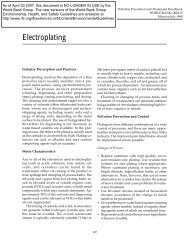SME Finance Policy Guide
SME Finance Policy Guide
SME Finance Policy Guide
You also want an ePaper? Increase the reach of your titles
YUMPU automatically turns print PDFs into web optimized ePapers that Google loves.
G-20 <strong>SME</strong> FINANCE POLICY GUIDE<br />
55<br />
governments and public funders. In several countries<br />
(e.g., India, Bangladesh, Colombia, Mali, Afghanistan)<br />
they have contributed to increasing financial access.<br />
But poorly designed apexes can waste time money<br />
and fail to meet their own goals. While each country<br />
has a different context that affects the success of an<br />
apex, the lessons outlined above can help governments<br />
and funders avoid major pitfalls.<br />
C.3.3 PARTIAL CREDIT GUARANTEE<br />
SCHEMES<br />
Many countries operate partial credit guarantee<br />
schemes (PCGs). In developed countries, such schemes<br />
have been operational for several decades, while their<br />
use in developing countries is more recent. Credit<br />
guarantee schemes can be organized in different ways<br />
but their core objective is the same: to guarantee the<br />
loans offered by a financial institution to a borrower<br />
subject to both the payment of a premium and a range<br />
of other rules and conditions. When default occurs,<br />
the lender is compensated by the guarantor as per the<br />
initial agreement. In some arrangements, the guarantor<br />
can benefit from a counter-guarantee from a higher<br />
level guarantee institution that is also subject to the<br />
payment of a premium.<br />
Credit guarantee schemes are one of the most marketfriendly<br />
types of interventions, as private financial<br />
institutions usually retain a primary role in the screening<br />
of borrowers and final lending decision. Unlike<br />
other types of interventions, such as state banks or<br />
directed lending arrangements, they may generate<br />
fewer distortions in the credit market and may lead to<br />
better credit allocation outcomes 61 ). Guarantee schemes<br />
may prove an effective vehicle for reaching underserved<br />
groups such as start-ups and small firms. They<br />
may also generate positive externalities by encouraging<br />
banks to get into the <strong>SME</strong> market and improving their<br />
lending and risk management systems. Guarantee<br />
schemes have also been used for countercyclical<br />
purposes and the recent financial crisis highlighted the<br />
importance of this countercyclical role.<br />
Credit guarantee schemes can be organized in different<br />
ways, such as mutual guarantee institutions, credit<br />
guarantee banks, or credit guarantee funds owned and<br />
operated entirely by the public sector or by a combination<br />
of public and private shareholders. Some countries<br />
maintain different types of credit guarantee schemes.<br />
Mutual guarantee institutions are typically private institutions<br />
with a mutual legal structure created by the beneficiary<br />
<strong>SME</strong>s. Their capital is provided directly by the <strong>SME</strong>s<br />
that apply for a loan guarantee in the form of cooperative<br />
or mutual shares. Each member has equal voting rights in<br />
electing the general assembly and board of directors.<br />
Mutual guarantee institutions are usually run by entrepreneurs,<br />
bringing an <strong>SME</strong> perspective to risk assessment<br />
and management. They are very common in Europe but<br />
also exist in some emerging countries.<br />
Guarantee banks are legally structured as private foundations<br />
or joint stock companies, and can be owned by<br />
a variety of private shareholders such as chambers of<br />
commerce and industry, commercial or savings banks,<br />
banking associations, and insurance companies. They<br />
can be regulated and supervised as other financial<br />
institutions. Guarantee banks are an important component<br />
of the German credit guarantee system.<br />
Partial credit guarantee schemes created, funded, and<br />
managed by the public sector (the government and/<br />
or the central bank) are one of the most common<br />
types of guarantee schemes. They are usually legally<br />
independent entities and can be managed independently<br />
or by another public institution such as a state<br />
development bank or state development fund. In<br />
many cases, the ownership structure is mixed, combining<br />
the state, commercial banks, and other private<br />
shareholders. In a few cases, participating banks are<br />
the dominant shareholders.<br />
61 Beck and De la Torre, 2006














![Print a two-page fact sheet on this project [PDF] - IFC](https://img.yumpu.com/43449799/1/190x245/print-a-two-page-fact-sheet-on-this-project-pdf-ifc.jpg?quality=85)


